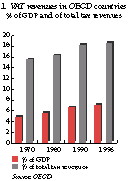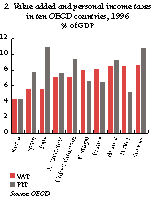|
|
|
|

The OECD Observer
January 1999, No. 215
Taxing Financial Services: A Future with Options
By Andrew Scott
VAT is a key part of the fiscal revenue of many countries. Yet financial services are exempt from it. Why? And what are the economic implications of this exemption and the options open to governments in their attempt to prevent market distortions?
Value added tax (VAT) is a broad-based tax on household consumption. With the exception of Australia 1 and the United States, all OECD countries levy VAT, or a similar tax, on consumer expenditure. Over the years the importance of VAT as a source of revenue has been on the increase (chart 1). In some countries, such as France and Turkey, the revenue yield from VAT exceeds that from personal income tax (chart 2). VAT is a broad-based tax on consumer spending, but some services are VAT exempt, including most financial services. This state of affairs may seem puzzling to some, especially given the significance of that sector and the size of its value-added in today’s world economy.

The reason why financial services should typically be exempt from VAT is a practical one. No country has found an entirely suitable and straightforward way to tax them. New Zealand, for example, examined the idea when they introduced VAT in 1986, but quickly abandoned the attempt. On close study it proves hard to determine the tax base, in part because of uncertainty over the true nature of the service provided. Also, there is a question about whether it is reasonable to charge a consumption tax on transactions which are often directly related to household saving. Another problem is that subjecting those services to VAT might, by extension, require smaller non-finance sector companies to charge and collect tax in respect of money they have deposited with banks, since those deposits are effectively loans. Such considerations have led to the introduction of various special consumption taxes on financial services, such as the insurance premium taxes paid by the policyholders. It should be noted that businesses which provide VAT exempt services must pay VAT on such expenses as computer services and stationery.

Economic Distortions
VAT is levied on the value that is added by business at each stage of the production process. The tax is collected by an elegant mechanism. In principle, firms charge VAT on all of their sales. Before handing the VAT revenue collected from their customers to the fisc, firms will deduct the VAT already charged to them by their suppliers. As a result, each firm pays exactly the tax due on the value it has added. Businesses that provide VAT exempt services and those not engaged in economic activity, for example, non- business organisations and private consumers, have no right to deduct prepaid VAT. As a consequence, those sectors and households end up paying the total amount of VAT included in the prices of the goods and services they buy. This explains why some so-called exempt institutions, such as charities, find themselves ‘stuck’ with the VAT on the goods they buy from companies.
Services which are exempt from VAT include medical, housing and financial services. The latter involve mainly banking services, dealing in shares, insurance and related brokerage services. Providers of exempted services charge no VAT to consumers. Enterprises providing exempted services, however, cannot recover the VAT included in prices of goods and services they buy from their suppliers, such as computer, accounting and legal services. This VAT, sometimes referred to as ‘hidden’ or ‘sticking’ tax, ends up by being included in the cost of services sold by banks, insurers and other providers of financial services. It is in this sense that the exempt financial institutions incur VAT costs.
If enterprises subject to VAT buy the exempted services they cannot then reclaim the hidden tax. Thus when businesses selling taxable goods use financial services, the price of the goods probably includes the amount of VAT included in the cost of financial services. In this instance the amount of VAT payable is calculated on a price which includes some tax. This leads to a ‘tax on tax’ effect and goes against the principles of the VAT system, which is designed to tax only the value-added at each stage of production. It may also create a distortion of competition, especially at the international level. For example, there may be an incentive for companies to import services which are free of tax in preference to buying from local providers whose services may include some hidden VAT. Other distortions are possible, such as the case where certain professional services provided by an exempted financial institution may escape VAT legitimately, while other providers are subject to the tax, potentially making theirs more expensive. Surveyors’ services to house-buyers is a good example of this. When provided as a distinct and separate service by an independent expert, those services would be subject to VAT. If a bank provides the service in providing the mortgage loan the VAT will not be charged on any survey fee.
To remove any distortion a feasible method of taxing financial services has to be found. If the current exemption were eliminated, banks and insurers could claim all prepaid VAT and such distortions would no longer occur. The financial institutions would, however, be required to charge VAT on their services. The calculation of the taxable amount may not be so difficult for relatively straightforward services, such as the operation of a bank account where the amount of value added can be calculated, or share-dealing services where a fee is charged. But financial service businesses engage in a vast range of transactions, such as institutional investments, which may seem far removed from customer services, but which are nonetheless related to the provision of services to clients. Arrangements for a comprehensive system of taxation have therefore proved problematic. Moreover, the cost of system changes and on-going administration for banks and revenue authorities leads to questions about the relative merits of any reform.
A Revenue Paradox
As in most problems with seemingly straightforward answers, there is a paradox in that it is not certain that the exemption for financial services has any effect on the revenue collected under VAT. If the current exemption were replaced and these services were subjected to VAT, revenues would in part be lost because financial industries would claim pre-paid VAT. Moreover, other indirect taxes on financial transactions, for example on insurance premium taxes, may have to be repealed or reduced as a consequence of bringing these transactions into the VAT net. There could be additional revenue generated from a positive rate of tax on these services. However, some governments remain sceptical of any estimate showing a net revenue gain.
VAT treatment of certain financial services and instruments in OECD countries differs considerably. Taking a comparatively straightforward example, credit card services, there is quite a disparity in the VAT treatment. The disparity ranges from services being outside of the scope of the tax to being exempt. Some countries, for example Germany, provide taxpayers with the right to opt to impose taxes on otherwise VAT exempt services. The legal basis for this somewhat unique taxation provision is available in accordance with European VAT law.
Financial services are evidently complex transactions. Care must be taken to ensure that in making any comparison of treatment, the services compared are exactly the same in every detail.
Options Open to Government
There are three options open to government to deal with the VAT conundrum. The first is to maintain the status quo. Continuing with the exemption of financial services for VAT has the attraction of ‘staying with the devil you know’.
A second option would be to bring these services into the VAT net, which would imply a major change in the existing coverage of VAT and raise issues on how to measure value-added by financial institutions.
A third option would be to look for a radically new approach to taxing these services, but still under VAT. The European Commission, for example, is currently exploring the feasibility of taxing them on a ‘cash flow’ basis. The aim is to apply tax to the value-added to services provided by banks and insurance companies, for example by taxing cash movements. As a basis of tax on value added for credit transactions for example, the difference between the charge made to borrowers and the rate of interest paid to investors could be targeted. In the case of insurance, VAT could be paid on the difference between premium income and the sum of claims met. This approach helps to identify value added and may lead to solutions for some of the technical problems previously identified.
At this stage it is unclear which of these options will find favour. But given the global stature of the financial services industry, whichever option is chosen it is essential to have an internationally coherent set of rules.
OECD Bibliography
Indirect Tax Treatment of Financial Services and Instruments, forthcoming 1999
Revenue Statistics of OECD Member Countries, 1998
Tax/Benefit Position of Employees, 1998
Consumption Tax Trends, 1997
Environmental Taxes in OECD Countries, 1995.